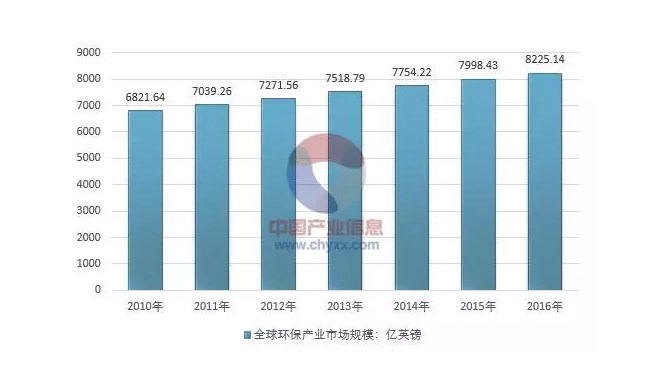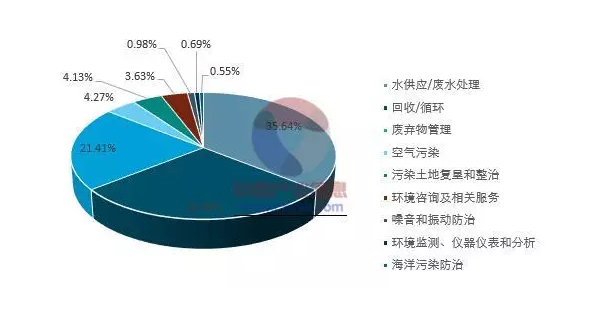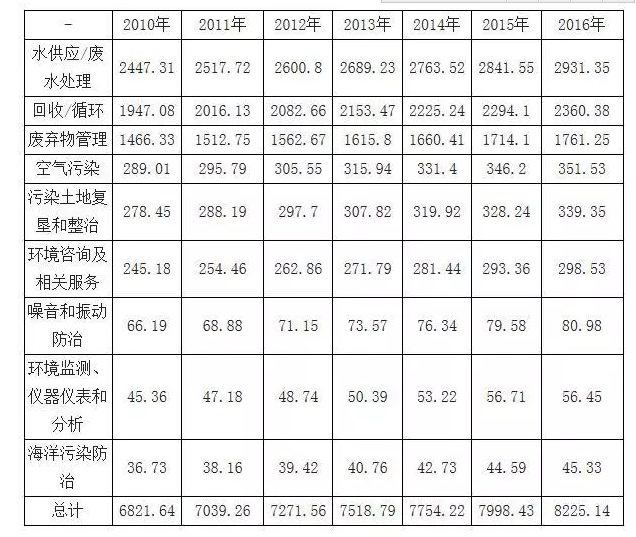Analysis of the global environmental protection industry market size, industrial structure and development characteristics in 2017
Date:
2017-09-26 13:16
Source:
Source: At present, the most representative development of environmental protection industry in the world is the United States, Japan, Canada and Europe. The United States is the largest country in the environmental protection market today, accounting for 1/3 of the total value of the global environmental protection industry. Japan's environmental protection industry has developed rapidly in the design and production of clean products. For example, the production of green automobiles and transportation equipment ranks in the forefront of the world. Energy-saving products and biotechnology are also the objects of concentrated development of Japan's environmental protection industry. The key enterprises in the environmental protection equipment industry are: General Electric Company of the United States, Toshiba, Mitsubishi Heavy Industries, Kawasaki Heavy Industries, Siemens AG Power Generation Company, Flottweiwu Environmental Protection Co., Ltd., etc. From the perspective of the development trend of the world's environmental protection industry, the environmental protection equipment will develop in the direction of complete sets, cutting-edge and serialization, and the environmental protection industry will develop from the terminal to the source control, and its development focus includes air pollution prevention, water pollution prevention, solid waste treatment and prevention , noise and vibration control, etc. In addition, the current developed countries have set up "green barriers" in international trade, which has brought huge business opportunities and challenges to the world's environmental protection equipment industry. In the past, the environmental protection industry that people referred to was limited to products, equipment, services and technical projects for the treatment of air pollution, waste water, garbage, noise, soil and marine pollution and environmental monitoring. The connotation of the environmental protection industry in modern society has been extended to the development of new fields with the effects of preventing and reducing pollution, saving energy and reducing resource input, thereby promoting the development and maturity of a variety of new industries and services, such as promoting new Rapid marketization of solar energy, wind energy, hydrogen energy, biomass energy, etc. in the energy industry. At present, the development of energy conservation and environmental protection industries and energy conservation and emission reduction technologies has become a new field of international economic and technological competition. In the process of responding to the international financial crisis, countries around the world, especially developed countries, have introduced policies, invested huge amounts of money, increased support for energy conservation, environmental protection, renewable energy and low-carbon technologies, and strived to seize the commanding heights of future economic and technological competition, and tried to pass Formulate stricter emission reduction rules and set up carbon tariff barriers, dominate the new rules of the global economy, and raise the production costs and market entry barriers of developing countries. These trends will have an important impact on my country's future development, requiring us to accelerate the development of energy conservation, environmental protection and new energy industries, and actively explore a green and low-carbon development path with Chinese characteristics. This can not only avoid the "lock-in effect" of the economic and social development model on carbon emissions, but also accelerate the upgrading and transformation of traditional industries by vigorously developing energy-saving and emission-reduction technologies, and strive to build a more economical, cleaner, more efficient, more people-friendly, A more competitive modern industrial system, improve the international competitiveness of products, and achieve a win-win situation for economic development and energy conservation and emission reduction. With the growing voice of global economic integration, environmental protection and sustainable development, the world environmental protection market also has a momentum of rapid development. Developed countries and regions have absolute advantages in technology level and market share. In 2016, the global environmental protection industry market The scale will reach 822.514 billion pounds. The water supply/wastewater treatment, recovery/recycling, and waste management markets are expanding. In 2016, the global environmental protection industry has the largest market in water supply/wastewater treatment, reaching £293.135 billion; followed by recycling/recycling, with a market size of £236.038 billion; and waste management, which ranks third with a market size of 176.125 billion GBP.

Market structure of global environmental protection industry in 2016

Analysis of the market structure of the global environmental protection industry from 2010 to 2016 (billion pounds)

Development characteristics of environmental protection industry (1) Energy conservation and environmental protection have become a new field of international economic and technological competition. The diversity and complexity of environmental protection issues require that the environmental protection industry must focus on technological innovation and accelerate industrial technology research and development and the practical application of scientific research results. , improve the application penetration rate of advanced technology and equipment, promote the improvement of the overall technical level of the industry, and meet the growing demand for environmental protection. In the process of responding to the international financial crisis, countries around the world, especially developed countries, have introduced policies, invested huge amounts of money, increased support for energy conservation, environmental protection, renewable energy and low-carbon technologies, and strived to seize the commanding heights of future economic and technological competition, and tried to pass Formulate stricter emission reduction rules and set up carbon tariff barriers, dominate the new rules of the global economy, and raise the production costs and market entry barriers of developing countries. Developed countries have established a national technical standard system that adapts to the development of the market economy and has reached a stage of perfection, virtually establishing a solid green trade barrier. Under the perfect environmental protection technical standard system, the standard has penetrated into all aspects of social life in developed countries, providing technical support for laws and regulations, and has become the environmental protection industry market access, contract maintenance, trade arbitration, conformity assessment, product inspection, quality system Basic basis for certification, etc. For example, the rapidly rising PM2.5 problem in recent years, the United States took the lead in proposing PM2.5 monitoring standards as early as 1997, and major developed countries such as the United States and the European Union have incorporated PM2.5 into air quality standards and imposed mandatory restrictions. (2) The PM2.5 monitoring equipment market is expected to usher in explosive growth. There are three technical routes for monitoring PM2.5 parameters, namely the oscillatory balance method, the beta-ray method, and the spectroscopic method. The domestic and foreign manufacturers adopting the oscillating balance method technology route mainly include Thermo Fisher, Landun Optoelectronics and Wuhan Tianhong, etc., while the manufacturers adopting the β-ray method technology route are American METONE, French ESA, Xianhe Environmental Protection, Wuhan Tianhong, etc. enterprise. Among them, Thermo Fisher accounted for more than 50% of the market share of the oscillatory balance method. European and American countries have developed earlier in terms of PM2.5 monitoring equipment, but there are certain technical barriers and high prices. After more than 40 years of governance in foreign countries, such as the United States, atmospheric PM2.5 has basically reached the standard, and the United States has higher standards in PM2.5 governance, so its equipment is more mature. The increasingly frequent haze weather forces the progress of PM2.5 prevention and control to accelerate. As more and more regions join the PM2.5 monitoring team, the market opportunities brought by this are gradually revealed. According to the timetable of the Ministry of Environmental Protection of my country, starting from 2016, all parts of the country will monitor and evaluate the ambient air quality according to the new standards, and release the monitoring results to the society. Therefore, my country's PM2.5 monitoring equipment market has broad prospects in the future. (3) "Energy-saving equipment + EMC" model opens up a low-carbon development path Under the pressure of energy-saving and emission reduction, the potential energy-saving market demand is continuously stimulated: industrial energy-saving equipment manufacturers will transform into energy-saving service providers. In the energy-saving market, energy management contract (EMC) of energy-saving service companies has become the main model. After the introduction of the "contract energy management" model in the sales of energy-saving equipment, the market share of energy-saving equipment has increased rapidly. By adopting this flexible sales method, energy-consuming enterprises can share energy-saving benefits without investment. Not only can they enjoy energy-saving benefits for a long time, but they can also obtain current advanced technology and equipment, which improves the reliability of retrofitted equipment and enhances the company's Competitiveness.
relevant
2021-09-15


